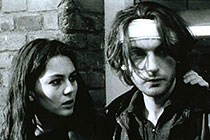|
|
|
|
Sauvage
innocence
|
 |
|
Sauvage innocence is Garrel's best film since La Naissance de l'amour (1993). What is most immediately striking is the quiet vigour of montage and framing: the plastic aspect of Garrel, the balance of pictorial forces across and through the full length of the black and white cinemascope frame, as well as the interplay of music and image, has never been livelier. How dynamic and varied these images are, even within the quiet, minimalist, chamber mode that is the director's signature key. It is never terribly easy to say what Garrel's films are about or what they address, since one can too easily take refuge in formulaic chestnuts that cheapen the work: pure art versus filthy commerce, a filmmaker's struggle to create, the deadly mirror posed between cinema and life (via that arthouse stock-in-trade, the film-within-a-film). It is also easy to simply not connect with Garrel on the assumption that he has done all this before (raking over his years and experiences with Nico – within the film, even old papa Maurice Garrel incredulously exclaims "Again?" when his son outlines his latest project), or that his work simply replays, long after the use-by date, the pale aura of the Nouvelle Vague (Parisian couples sitting in cafes, strolling the streets.). Garrel may always remain, hélas, a minority taste for the happy, chosen few. But while Sauvage innocence intricately moves around familiar pieces of Garrel's ongoing, autobiographical roman, and derives its moody poetry from the motifs that the director has, over nearly forty years, made all his own – doors, phones, beds, windows, walks, letters, cars, chance meetings and agonising separations – there is a also a bracing, wild note of melodrama new to his work. (And also – in the scenes devoted to a fickle, old producer and the little clapperboard gag that heralds legendary cinematographer Raoul Coutard as "Raoul C. Maître" – an unexpected Garrelian comedy.) Scenes of vicious arguing, sexual infidelity and drug taking have an emotional rawness and (for Garrel) an explicitness that is, in this context, frankly shocking. Above all, there is a villain, a figure of evil the likes of which we have never seen in a Garrel film – a drug-dealing fallen angel incarnated unforgettably by Michel Subor, whose mere entrance into the frame makes one's skin crawl (could Garrel have been inspired by the equally chilling figure of the agent played by Everett Chambers in Cassavetes' Too Late Blues, 1961, a seminal film about artistic compromise?). So what is Sauvage innocence about? Here, one must grasp Garrel's very particular and finely honed attitude towards cinematic fiction (no doubt refined with his writing collaborators since the '80s, pre-eminently Marc Cholodenko). The Garrelian universe is a chessboard of positions, elaborated from film to film: parent and child (no matter their ages), spouse and lover, faithful or faithless friend. Women tend to come in three very personalised "archetypes" for Garrel: the Nico figure (sauvage, tragic, forever a ghost who returns); the wife-and-mother (figure of redemption, healing, home and hearth); and the (younger) lover, who brings liberation from one or another creative or sentimental prison. Fiction is generated in and by the small, slow but decisive movement or transformation from one archetype into another: when the hero loses his father and must finally assume that position himself, or when the lover faces the anxiety of becoming the wife, both of which happen in Cour fantôme (1996). Here, the transformation is less expected and more violent: from lover to Nico-substitute, "dead again" as surely as Kim Novak in Hitchcock's Vertigo (1958). It is little wonder that Sauvage innocence's primal scene of emotional rupture – the man's writing and the woman's reading of the letter that fatally alters the direction of both their destinies – is among the most powerful and wrenching he has ever composed. But what is also new about Sauvage innocence is the critical distance that Garrel takes from his (youthful) alter ago, superbly incarnated by the Situationist-Lacanian author of The n Essence of Love, Mehdi Belhaj Kacem (whose own blooming as an actor in the course of the movie coincides exactly with the character's own arc of confidence: only on set does he really come alive). This character's vision is based on a denial – not only of the evidence before his eyes of his lover's dissolution and corruption, but of his own complicity with the past story he restages. His moralism is (it is hinted) a massive and complex defence mechanism; and it tempts the most horrifying of fates. Like many great movies, this one has an unspoken secret at its centre. MORE Garrel: L'Enfant secret, J'entends plus la guitare, Lover for a Day, The Salt of Tears, La cicatrice intérieure © Adrian Martin March 2002 |
![]()